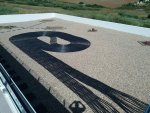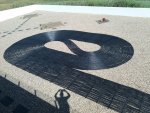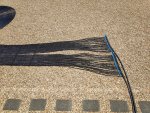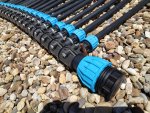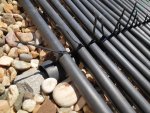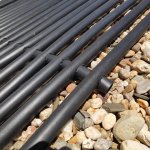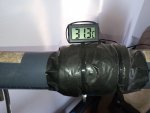My solar pool heater
- Thread starter Zeerob
- Start date
You are using an out of date browser. It may not display this or other websites correctly.
You should upgrade or use an alternative browser.
You should upgrade or use an alternative browser.
My pool is 5x10 m.
The heating is made of 20 x 100m x 25 mm PE agricultural tube.
And a few meters of 50 mm feeding tube.
The 50 mm tube splits into the 20 smaller tubes.
The total area of the tubes is 2000 m x 25 mm = 50 m2 which is equal to the area of the pool.
We also have a bubble cover on a winder.
I have a variable speed Hayward pump, and the heating is just connected in the circuit of the pool filter, after the filter and before the SWG. There are 3 valves: in the feed and returns and a bypass. I manually turn the heater on (with the valves ) when there is enough sun. At night it is normally off. The night is normally quit cold here, and the water will cool down quickly when the sun is under.
The tubes are 25 mm with 15 between them, so 40 mm apart. This is to prevent one tube shading the next one when the sun is a bit lower.
The construction is: first I buried 50 mm tubes in the gravel, and connected the 25 mm tubes on them. Between those 50 mm tubes are 'spacers' that keep the tubes more or less at the correct distance from each other. These 'spacers' are made of 25 mm tubes with 25 mm holes drilled in, see picture. I used a 25 mm diamond glass drill for that. You can get those on ebay for a few dollars.
The extra 15 mm between the tubes makes it work better, but that was a lot of extra work. If I would have just tied the tubes together without the 15 mm spacing, it would have been less work.
The heating works very well. I very easily get the pool at 28 C. Even at the end of March, the water was 28.5 which is extraordinary in our climate. I have recently refilled my pool with cold water. We had a very hot day after refilling (34 C) and the pool went up from 23.5 to 29.5 C in one day.
I have a cheap digital thermometer on the feed and return tubes. So, you can see how much it heats. The variable speed pump is essential for this. I usually run the pump at around 1500 rpm with the heating on.
The heating is made of 20 x 100m x 25 mm PE agricultural tube.
And a few meters of 50 mm feeding tube.
The 50 mm tube splits into the 20 smaller tubes.
The total area of the tubes is 2000 m x 25 mm = 50 m2 which is equal to the area of the pool.
We also have a bubble cover on a winder.
I have a variable speed Hayward pump, and the heating is just connected in the circuit of the pool filter, after the filter and before the SWG. There are 3 valves: in the feed and returns and a bypass. I manually turn the heater on (with the valves ) when there is enough sun. At night it is normally off. The night is normally quit cold here, and the water will cool down quickly when the sun is under.
The tubes are 25 mm with 15 between them, so 40 mm apart. This is to prevent one tube shading the next one when the sun is a bit lower.
The construction is: first I buried 50 mm tubes in the gravel, and connected the 25 mm tubes on them. Between those 50 mm tubes are 'spacers' that keep the tubes more or less at the correct distance from each other. These 'spacers' are made of 25 mm tubes with 25 mm holes drilled in, see picture. I used a 25 mm diamond glass drill for that. You can get those on ebay for a few dollars.
The extra 15 mm between the tubes makes it work better, but that was a lot of extra work. If I would have just tied the tubes together without the 15 mm spacing, it would have been less work.
The heating works very well. I very easily get the pool at 28 C. Even at the end of March, the water was 28.5 which is extraordinary in our climate. I have recently refilled my pool with cold water. We had a very hot day after refilling (34 C) and the pool went up from 23.5 to 29.5 C in one day.
I have a cheap digital thermometer on the feed and return tubes. So, you can see how much it heats. The variable speed pump is essential for this. I usually run the pump at around 1500 rpm with the heating on.
WOW! That's beautiful! Is it on your roof or just a flat bed made for this purpose alone?
I think a lot of folks will enjoy seeing this. Thanks for sharing. So glad it works for you!
Maddie
I think a lot of folks will enjoy seeing this. Thanks for sharing. So glad it works for you!
Maddie
The pattern that I have chosen has some advantages over a spiral.
First note that the 20 tubes are connected in parallel, not in series. In series, the flow of water would be too low, and the pressure loss would be way to high. An advantage is also that the difference in length between the outer and inner tube (of the 20 tubes) is a lot less than with a spiral.
If you run the water more slowly, the temperature gain will be higher, but the volume per hour will be lower. You may wonder what works best. Well, the answer is, the faster the water runs the better it is. This can be explained like this:
The energy of the solar radiation that is captured by the tubes goes partly to the pool, and partly to the air (when the tubes get hotter, they will heat the air, or will be cooled by the wind). So:
Solar energy (in) = pool energy (out) + energy loss to air
The faster the water flows, the less hot the tubes will get, and the less energy you will lose to air, and the more remains for the pool.
With normal sun, I will get about a 4 C temperature gain, depending of wind, time of day, and pump speed. So, if I want the pool to get hotter, I may run the pump a bit faster.
First note that the 20 tubes are connected in parallel, not in series. In series, the flow of water would be too low, and the pressure loss would be way to high. An advantage is also that the difference in length between the outer and inner tube (of the 20 tubes) is a lot less than with a spiral.
If you run the water more slowly, the temperature gain will be higher, but the volume per hour will be lower. You may wonder what works best. Well, the answer is, the faster the water runs the better it is. This can be explained like this:
The energy of the solar radiation that is captured by the tubes goes partly to the pool, and partly to the air (when the tubes get hotter, they will heat the air, or will be cooled by the wind). So:
Solar energy (in) = pool energy (out) + energy loss to air
The faster the water flows, the less hot the tubes will get, and the less energy you will lose to air, and the more remains for the pool.
With normal sun, I will get about a 4 C temperature gain, depending of wind, time of day, and pump speed. So, if I want the pool to get hotter, I may run the pump a bit faster.
Last edited:
Hi Maddie,
Thanks! It is in our lower garden. Our house is on a slope (south east facing) and after the pool is a wall down. The picture is taken from the terrace with the pool. This lower garden is only visible when standing at the edge of the terrace and we have mostly gravel in it.
Thanks! It is in our lower garden. Our house is on a slope (south east facing) and after the pool is a wall down. The picture is taken from the terrace with the pool. This lower garden is only visible when standing at the edge of the terrace and we have mostly gravel in it.
I imagine the gravel heat up also and contribute to the warming, right?
Just great. I am seriously impressed.
Just great. I am seriously impressed.
Yes, the gravel also heats up. But it can be windy here and then the wind cools everything. I noticed that the fact that the tubes are black also helps. On a cloudy day, when you still feel a bit of sun, the heater still works but my yellow garden hose that lays in the sun, hardly heats up.
Nice work, I like the spacers. If you don’t mind me asking, what was your cost? This is one of the few self made systems that really has sufficient surface area!
It would also be interesting to measure volume of water and corresponding temp rise to see how efficient different pump speeds are.
Hi Captain, thanks! Total cost was about EUR 750. Mainly for the 2000 m of 25 mm tube, the saddles (T connectors) and one roll of 50 mm tube. I already had the 3 valves in the installation, in anticipation of some form of heating. I have replaced the bolts in the saddles with inox ones. Needles to say that it was quit a lot of work, and a lot of PE drilling was involved 
Also note that the base 50 mm tubes that were buried in the gravel are nailed to the ground with long nails.
My pool volume is 89 m3, but I will add some calculations.
Also note that the base 50 mm tubes that were buried in the gravel are nailed to the ground with long nails.
My pool volume is 89 m3, but I will add some calculations.
I will now add some calculations. All calculations are in metric.
First, let me tell something about the role of water speed (flow) and of the temperature delta of a tube (output - input temp). An example on a not so warm day:
- water temperature = 20 C
- air temperature = 18 C
- the sun is shining
Stop the water in the tube, and leave it for some time in the sun, until the temperature does not rise anymore. You can do that with a garden hose. Then measure the temperature of the water in the hose. Lets say it is 30 C.
If you now flow water through the tube, the output temp will be somewhere between 20 and 30 C. If the water would flow extremely fast, the temp would be close to 20 (it would hardly heat up), and if it would flow very slow, it would be close to 30.
With a very high speed (flow), you would be taking the maximum possible energy to the pool.
If you would flow water through the tube with such a speed that the output would be 25 C, you would more or less be getting half of the maximum energy. So, it would be better to have a higher water speed (flow), so that the output water would be for example 22 C. Then you would be getting 80% of the maximum energy.
Note that this a bit simplified, I am ignoring the thermal resistance of the tube wall here.
So, the lower the delta between input and output temp, the better, and you have to compare that delta to how hot the water in the tube would get if there would be no flow.
I assumed that on good day, the standstill temp might be 40-50 and I aimed for a delta of max 4-5 C.
The next question is, how fast will the water have to flow to get the desired delta?
Suppose that the inner diameter of a 25 mm tube is 20 mm. I used 100 m tubes.
So, 100 m of tube holds 31.4 L of water.
The surface of that tube is 25 mm x 100 m = 2.5 m2
The energy of the sun is about 1000 Watt / m2
Because the sun is shining at an angle, assume 800 W / m2
So, the tube gets 2.5 x 800 = 2000 W
The energy to heat 1 L of water by 1 C is: 4.184 kJ
To heat our tube with 31.4 L by 1 C takes 4.184 * 31.4 = 131 kJ
At 2 kW, heating the tube by 1 C takes 131 / 2 = 65.5 seconds.
To get a delta of 4 C, the water has to stay 4 x 65.5 = 260 seconds in the tube.
So, the flow must be 31.4 L in 260 seconds = 0.435 m3 / hour.
Note that this is per tube, so with 20 tubes in parallel, the total flow is 8.7 m2 / hour, which sounds like a reasonable flow with my pump.
The next question is, how much pressure loss will it cost to push that amount of water through these pipes.
I have used this website (Dutch) to calculate pressure loss:
- Drukval in buisstroming
A flow of 0.435 m3 / hr through a 100 m tube of 20 mm (inner) requires a pressure of 0.123 bar.
The total length of the 50 mm feed / return tubes is about 10 m.
A flow of 8.7 m3/hr through 10 m tube of 44 mm (inner) requires 0.056 bar.
So, total pressure loss = 0.179 bar. Add some for corners, etc, and total loss = 0.2 bar.
This is reasonable in my low pressure system with an oversized cartridge filter.
0.2 bar equals the pressure of a water column of 2 m.
These calculations are not 100% exact, but it will give you an idea how to choose pipe diameters and how many pipes in parallel, etc.
First, let me tell something about the role of water speed (flow) and of the temperature delta of a tube (output - input temp). An example on a not so warm day:
- water temperature = 20 C
- air temperature = 18 C
- the sun is shining
Stop the water in the tube, and leave it for some time in the sun, until the temperature does not rise anymore. You can do that with a garden hose. Then measure the temperature of the water in the hose. Lets say it is 30 C.
If you now flow water through the tube, the output temp will be somewhere between 20 and 30 C. If the water would flow extremely fast, the temp would be close to 20 (it would hardly heat up), and if it would flow very slow, it would be close to 30.
With a very high speed (flow), you would be taking the maximum possible energy to the pool.
If you would flow water through the tube with such a speed that the output would be 25 C, you would more or less be getting half of the maximum energy. So, it would be better to have a higher water speed (flow), so that the output water would be for example 22 C. Then you would be getting 80% of the maximum energy.
Note that this a bit simplified, I am ignoring the thermal resistance of the tube wall here.
So, the lower the delta between input and output temp, the better, and you have to compare that delta to how hot the water in the tube would get if there would be no flow.
I assumed that on good day, the standstill temp might be 40-50 and I aimed for a delta of max 4-5 C.
The next question is, how fast will the water have to flow to get the desired delta?
Suppose that the inner diameter of a 25 mm tube is 20 mm. I used 100 m tubes.
So, 100 m of tube holds 31.4 L of water.
The surface of that tube is 25 mm x 100 m = 2.5 m2
The energy of the sun is about 1000 Watt / m2
Because the sun is shining at an angle, assume 800 W / m2
So, the tube gets 2.5 x 800 = 2000 W
The energy to heat 1 L of water by 1 C is: 4.184 kJ
To heat our tube with 31.4 L by 1 C takes 4.184 * 31.4 = 131 kJ
At 2 kW, heating the tube by 1 C takes 131 / 2 = 65.5 seconds.
To get a delta of 4 C, the water has to stay 4 x 65.5 = 260 seconds in the tube.
So, the flow must be 31.4 L in 260 seconds = 0.435 m3 / hour.
Note that this is per tube, so with 20 tubes in parallel, the total flow is 8.7 m2 / hour, which sounds like a reasonable flow with my pump.
The next question is, how much pressure loss will it cost to push that amount of water through these pipes.
I have used this website (Dutch) to calculate pressure loss:
- Drukval in buisstroming
A flow of 0.435 m3 / hr through a 100 m tube of 20 mm (inner) requires a pressure of 0.123 bar.
The total length of the 50 mm feed / return tubes is about 10 m.
A flow of 8.7 m3/hr through 10 m tube of 44 mm (inner) requires 0.056 bar.
So, total pressure loss = 0.179 bar. Add some for corners, etc, and total loss = 0.2 bar.
This is reasonable in my low pressure system with an oversized cartridge filter.
0.2 bar equals the pressure of a water column of 2 m.
These calculations are not 100% exact, but it will give you an idea how to choose pipe diameters and how many pipes in parallel, etc.
Last edited:
I did not read all the details 
That is one of the nicer DIY solar panesl I have seen, but I have to think it cost you more than just buying some of the pool solar mats.
Also remember that solar heating works best at lower temperature deltas and higher flow rates. I think I saw you mention a 4 degree delta (almost like you were targeting that). Well, you will get more heat in your pool if you get more water flowing through it at a lower temperature delta. {although on 2nd read I think you realize this}
EDIT: Those are bigger tubes that I thought on first glance.
So this is similar to what the previous owner put on my house. Same type of tube, but there were only 8 parallel runs of 100 - 250 feet each. I think it was around 200 ft2.
They did not lay them out anywhere close to as nice as your setup, so there was a lot of self-shading. I got tired of dealing with the constant leaks that would start where things got kinked. Tore them out and installed 500 ft2 of panels.
That is one of the nicer DIY solar panesl I have seen, but I have to think it cost you more than just buying some of the pool solar mats.
Also remember that solar heating works best at lower temperature deltas and higher flow rates. I think I saw you mention a 4 degree delta (almost like you were targeting that). Well, you will get more heat in your pool if you get more water flowing through it at a lower temperature delta. {although on 2nd read I think you realize this}
EDIT: Those are bigger tubes that I thought on first glance.
So this is similar to what the previous owner put on my house. Same type of tube, but there were only 8 parallel runs of 100 - 250 feet each. I think it was around 200 ft2.
They did not lay them out anywhere close to as nice as your setup, so there was a lot of self-shading. I got tired of dealing with the constant leaks that would start where things got kinked. Tore them out and installed 500 ft2 of panels.
Last edited:
Hi Jason, thanks. Yes, I agree that a lower delta works best. That was what I was trying to explain in the details that you did not read 
The 4 C that I was aiming for is with a high solar input of 800 W / m2. Out of season, when I need the heating most, the delta will be less.
And when I really want to get as much heat as possible, I can run the pump faster.
The 4 C that I was aiming for is with a high solar input of 800 W / m2. Out of season, when I need the heating most, the delta will be less.
And when I really want to get as much heat as possible, I can run the pump faster.
Yes, 50 m2 is about 538 ft2, but because of the spacing between tubes, it is effective bigger when the sun is at an angle. This tube is very rigid. It will never kink and I have never had a leak. What sort of flow do you have through your panels and how much pressure does that take?EDIT: Those are bigger tubes that I thought on first glance.
So this is similar to what the previous owner put on my house. Same type of tube, but there were only 8 parallel runs of 100 - 250 feet each. I think it was around 200 ft2.
They did not lay them out anywhere close to as nice as your setup, so there was a lot of self-shading. I got tired of dealing with the constant leaks that would start where things got kinked. Tore them out and installed 500 ft2 of panels.
I think my pump is making about 40 GPM through my 500 sqft which is a little lower than I would want for efficiency, but I really do not need to add more heat.
I don't use a cover, so I lose a lot of the gains at night.
I do not recall the pressure differential with the solar on and off.
I don't use a cover, so I lose a lot of the gains at night.
I do not recall the pressure differential with the solar on and off.
That flow rate of 40 gpm seems low, I think Heliocol recommends a minimum of 5 gpm per panel. When I drop below about 62gpm (about 5.5gpm/panel) I start seeing lots of bubbles in my return.
I run 69gpm through my 550sq/ft of panels and see 2-4 degree differential depending on time of day
I run 69gpm through my 550sq/ft of panels and see 2-4 degree differential depending on time of day
There is no real minimum. The efficiency just suffers. Some members run them away much lower flow rates than mine. Location of the VRV also is important to how low you can run to keep it from pulling in air.
Honestly right now I think I may have 35GPM at most due to dirty filter.
Panels are still cool too the touch.
Honestly right now I think I may have 35GPM at most due to dirty filter.
Panels are still cool too the touch.
There is no real minimum. The efficiency just suffers. Some members run them away much lower flow rates than mine. Location of the VRV also is important to how low you can run to keep it from pulling in air.
Honestly right now I think I may have 35GPM at most due to dirty filter.
Panels are still cool too the touch.
I dunno, the Heliocol manual clearly states a minimum. Admittedly it doesn’t say why so like you say it probably just has to do with efficiency.

Well I guess any year now, going on 7, they are going to stop working due to the flow rate being too low 
Thread Status
Hello , This thread has been inactive for over 60 days. New postings here are unlikely to be seen or responded to by other members. For better visibility, consider Starting A New Thread.
Similar threads
- Replies
- 7
- Views
- 111
- Replies
- 6
- Views
- 264
- Replies
- 15
- Views
- 442
- Replies
- 13
- Views
- 416


